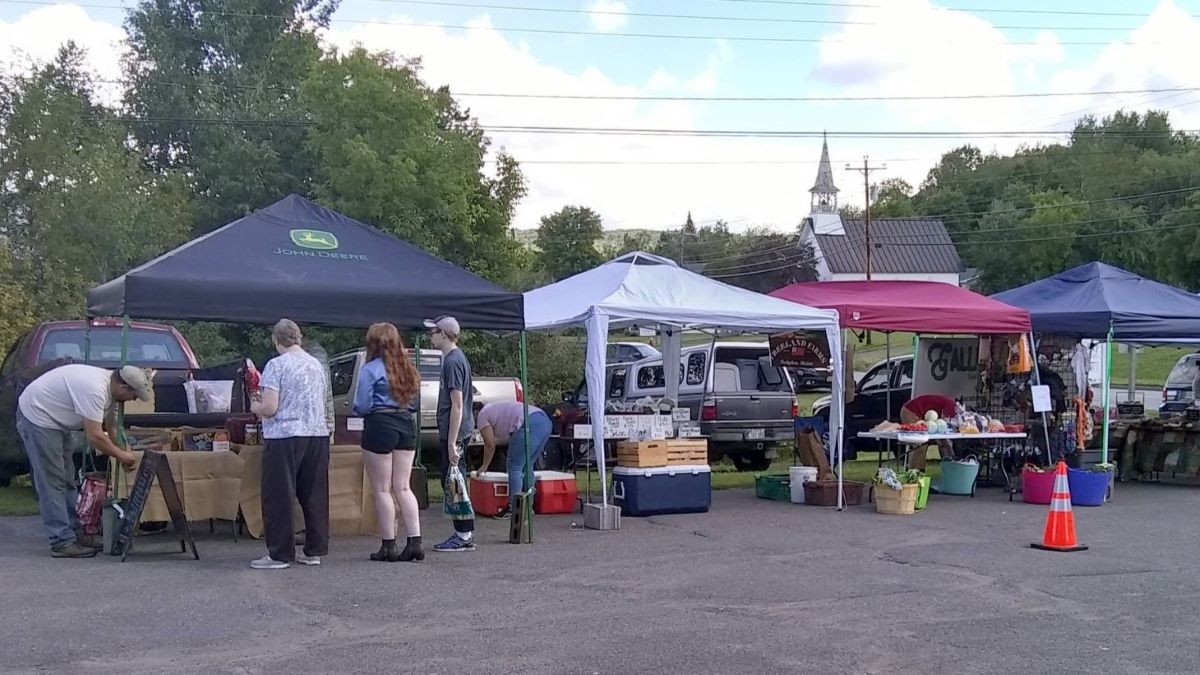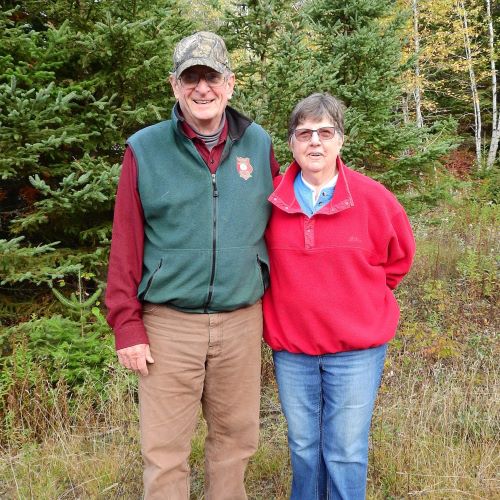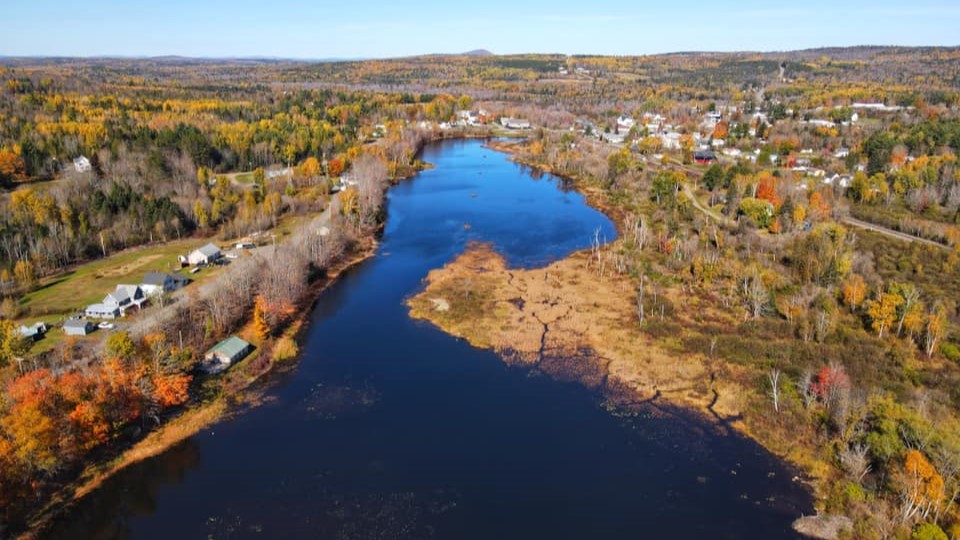As paper mills folded and other jobs in forestry were cut, opportunities and necessary services for the East Grand area’s roughly 2,000 year-round residents in the northern corner of Washington County and nearby Penobscot and Aroostook counties have mostly evaporated.
Faced with this stark reality, community leaders, deciding there might be strength in numbers, began working together to find solutions under the auspices of the citizen-designated Greater East Grand Region. In 2021, their vision took the form of a non-governmental organization, becoming the Greater East Grand Economic Council (GEGEC), created to boost the region’s prosperity.
At the top of the list is maintaining what they have left — only one of everything. One farm. One gas station. One restaurant. One health clinic. One hardware store. One retail grocery store. One bank.
“That’s it, down the line — one, and one, and one, and one,” said Elbridge Cleaves, who spent more than 45 years working in timberland management and forestry. “All it takes is for one of those to go and it’s the dominoes effect.”
Also tasked with coordinating new economic projects, the 501(c)3 was launched with foundation grants and support from the Sunrise County Economic Council (SCEC), a Downeast nonprofit, community development power broker. Its executive director, Charles Rudelitch, said the independent GEGEC has a better chance of succeeding than any initiative imposed from the outside.
“Personally, this is the most hopeful and exciting plan I’ve seen for economic development in the northern part of Washington County, definitely in the time I’ve been in this role,” Rudelitch said. “We’re glad that we have a small part in supporting it.”
Recognizing the challenge, the SCEC hired an employee to work full-time for the East Grand Economic Council’s executive director, currently the new group’s only position. To support the hire, the SCEC received funding from two multiyear grants: $200,000 from the Elmina B. Sewall Foundation, and $150,000k from the Charles F. and Beatrice D. Adams Foundation, as well as commitments from other organizations.
The expectation, Rudelitch said, is the economic council will transition to a fully, financially independent entity over the next three to five years.
Surmounting the scattered geography of the East Grand region is perhaps the biggest hurdle for the council. Christopher Hinshaw of Vanceboro, the executive director, will tackle the half-million-acre task.
Although Hinshaw, a former teacher and administrator, has only been on the job for three months, he’s already managed to cover roughly 1,700 miles and meet with about 70 people throughout the region.
“I try to avoid scheduling any meetings that would put me on the local roads and highways past dark because of moose and beer,” Hinshaw said.
Hinshaw hits the road daily, working to build trust and encourage collaboration between the disparate communities. He lives with his wife on a small homestead near Spednic Lake in Vanceboro, a nearly an hour drive from Danforth, the hub of the region. Vanceboro lies just beyond the imaginary boundary of the citizen-designated region.

According to the new economic council’s website, Greater East Grand includes the towns of Amity, Danforth, Haynesville, Orient and Weston; the plantations of Drew, Glenwood and Reed, including the village of Wytopitlock; the unorganized townships of Bancroft and Brookton Village, Forest City and Forest Twp., T11R3 NBPP, T7R2 NBPP, T8R3 NBPP, T3R3 Wels and T3R2 Forkstown, and the forest lands in the northerly parts of Codyville Plantation.
The region also shares a 40-mile boundary with New Brunswick. The sweeping landscape includes portions of the Middle and Lower Mattawamkeag River watersheds, the Baskahegan River flowage and most of the upper St. Croix watershed that runs through some of the region’s lakes dammed on the St. Croix River.
A potentially devastating blow to the environment — and the local economy — was averted in October when the St. Croix International Waterway Commission stepped in to manage the dam in East Grand Lake after the Woodland Pulp Mill announced it would no longer maintain the dam, which controls the lake’s water levels.
Residents and local officials say without the dam, the drop in East Grand Lake’s water level could have severely impacted property values, as well as fishing and recreation on the lake, a major tourism draw.
Hinshaw, who is also an historian, said knowing local history is an important part of his job. Although he’s only lived in neighboring Vanceboro for 10 years, he said people seem to trust him because he understands rural Downeast living, and he said that’s crucial.
Raised by an anthropologist father, Hinshaw spent some of his youth in a rural Mayan village in Guatemala.
As the only white people living among Indigenous people, Hinshaw said he learned the importance of understanding a region’s culture and people.
Sadly, Hinshaw said East Grand’s indigenous people, the Wabanaki, now represent only about 1 percent of the population, with most of them living in nearby Indian Township. He said his early life experience taught him the value of face-to-face conversations with the White settlers of the region.
“I get to listen to their story. And that’s really how I begin,” Hinshaw said. “I just listen. I don’t comment and I don’t make any judgment about what I’m hearing.”
Hinshaw and other community leaders say relationship building is critical to building consensus on what’s best for the region as a whole, rather than individual parts. But individualism is baked into the region’s culture.
Cleaves, a 74-year-old retired forester, is a fourth-generation patriarch of the region.
His great-great-grandfather came from Europe in the early 1800s to settle on Wabanaki land along the Baskahegan River.
The adventurer left for a time for the California Gold Rush, returning to the region at age 78 with a mail-order bride. Cleaves said it’s difficult for people in East Grand to recognize what can be done when you have a single voice representing a larger constituency.
“I’m not sure that’s a concept that is easily understood in the hinterlands,” Cleaves said. “People can’t just be told. So it will take time and it will take accomplishments.
The first accomplishment, broadband connection for 11 of the 12 communities, is near.

The agreement with Fidium Fiber, a subsidiary of Consolidated Communications, headquartered in Illinois, was signed this month and is expected to enter the design phase in early 2024 with the build-out anticipated by year’s end, according to Sara Strickland, the Robbinston-based consultant who facilitated the agreement.
The $8.1 million project is funded through the Maine Connectivity Authority’s “All-In” program, with money from the American Rescue Plan, designed to provide solutions to address the expansion of “last mile infrastructure” for high-speed internet, according to the agency’s website.
Described by Strickland as a game-changer for the region, the contract to provide 2G fiber internet to homes throughout the 11 communities (Amity has a separate broadband agreement) came after two years of planning. Funding was provided by the Maine Connectivity Authority, the Maine Community Foundation, three of the towns, and by Washington County with money from the Tax Increment Financing District (TIF) initially established to fund windfarms in the county.
According to Rudelitch, a good deal of the TIF funds not used for the windfarms have been invested in a revolving loan fund available to businesses in the Washington County unorganized territories. The money is available to make loans in perpetuity, Rudelitch said.
A potential candidate for a loan is an RV park on Route 1 that Hinshaw said he’s working to facilitate with an interested party. Although the communities once thrived from the lumbering industries with an abundance of services in every town, Hinshaw said there is virtually nothing left to entice tourists.
“We have no hotel or motel in the area. None,” Hinshaw said. “We have no place for an RV to even pull off the road for one night.”
Officials are pinning their hopes on high-speed broadband, which may attract remote workers who could become year-round residents. Broadband was one of the priorities identified 10 years ago by the Citizens Organization for Rural Education (CORE), the group behind the regional designation.
The community group — Cleaves was a founding member — also led the effort to keep East Grand Schools open when low enrollment threatened to permanently close the K-12 school.
A 2018 economic impact study conducted by CORE in partnership with the SCEC showed that closing the school, the region’s second-largest employer, would cripple an already fragile economy.
The school’s outdoor education program has been key to attracting students who could opt to go to schools outside the region, siphoning away precious tax resources. East Grand School is also “growing” young entrepreneurs for the region.
Through a $250,000 Department of Education Extended Learning Opportunity Award, the school pays seniors to work in the community while still attending school. Enticing young people to stay in the region is essential in this overwhelmingly aging region, where the population is, literally, dying out.
Ardis Brown, the Danforth town manager, said the community’s farmers’ market also allows students to try business ownership on a small scale.
In a conversation with The Maine Monitor earlier this year, Brown said the town can work with interested students after graduation to help them set up a storefront downtown.
“We’re trying to be supportive by letting them know what’s available through the SBA (Small Business Association) and different agencies,” Brown said. “We want to inspire them to take the leap and then be there to hold their hand a little bit while they do.”
Strickland was also hired as a consultant through grants from the SCEC and others to oversee the school preservation effort. Her acceptance in the communities helped Strickland with what she calls, “muscle-building,” the collaborative work she will continue to do under a new contract paid for with remaining broadband planning funds.
Strickland sees the school as one of the three prongs that are key to the region’s survival, with broadband, and building on abundant natural assets to create four-season tourism. Thanks to trail grooming being done by local snowmobiling clubs, she said the winter sport is already seeing an uptick.
“Snowmobilers are attracted to trails that are not super crowded and this is a region that has that,” Strickland said. “It’s an opportunity but everybody wants to manage it. They don’t want a traffic jam in the middle of the trails.”
Cleaves, who has been a caretaker of this serene and isolated landscape for a half-century, said that “love of place” and the history of the region are paramount. With his wife, Judy, the fourth-generation East Grand patriarch built First Settlers Lodge (now under new ownership) as a tribute to his ancestors who scaled the Wabanaki’s tall timbers and sculled the wild waters.
“Every one of us that are part of that vintage have been connected to the landscape, and have that same feeling,” he said. “If you can instill in others the same kind of love for a place, that will go a long way toward making improvements in the economic field.”







